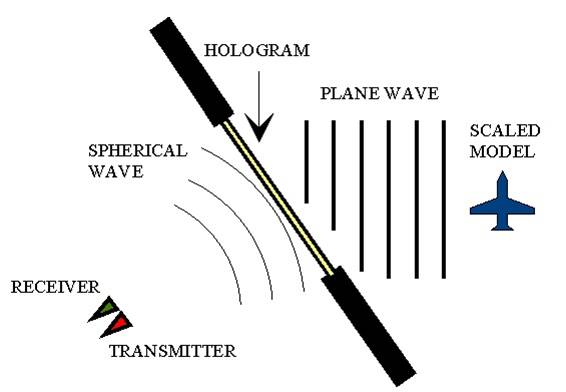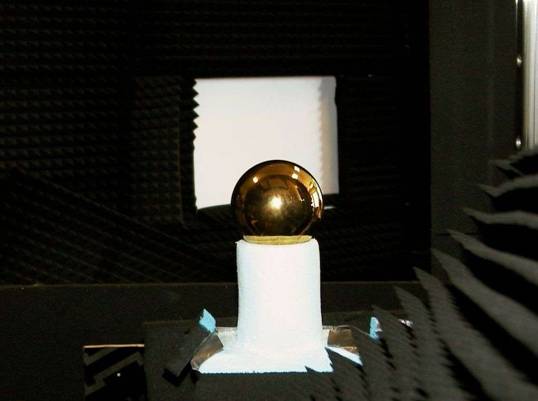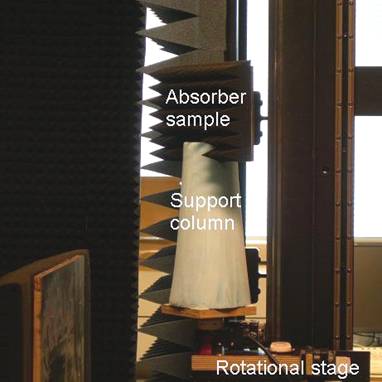A Phase Hologram Based Compact RCS Range
Scale Model Measurements
A compact test range for radar cross section (RCS) scale model measurements at 310 GHz has been developed. The plane wave needed for RCS determination is generated by a phase hologram. More traditional collimating elements (reflectors and lenses) are problematic in an RCS range at submillimetre wave frequencies. In comparison, a phase hologram has clear advantages such as an essentially planar and light-weight structure, considerably less stringent manufacturing tolerances, easier overall manufacturing with lower cost, and possibility of having even a portable compact range setup.
The basic advantage of any scale model RCS range is that the dimensions of radar targets are scaled down in proportion to the wavelength. Therefore, RCS data of originally large objects can be measured indoors in a controlled environment. After model measurements, the obtained RCS data is scaled back in order to get the real-sized target parameters. Model measurements can also be used for verifying computer simulation results especially in the case of targets with complicated structures.
The phase hologram used in the RCS range is a result of the recent Radio Laboratory research in the field of radio hologram applications. A phase hologram has a larger conversion efficiency than an amplitude hologram which is successfully used in CATRs. Good conversion efficiency is important especially in RCS measurements.
Our computer-generated phase hologram is a diffractive element, which consists of milled grooves in a dielectric plate. The hologram structure is locally optimized to generate the correct aperture field. The optimization parameters are the groove depth and width. Teflon is used as the base material due to its low loss, suitable permittivity, and satisfactory characteristics for manufacturing.
A large dynamic range is required in RCS measurements. In our case, the instrumentation is based on a millimetre wave vector network analyser (MVNA) with two sub-mm wave extensions. The measurements at 310 GHz are currently performed using a quasi-monostatic configuration where identical receiving and transmitting corrugated horn antennas are placed side by side. Continuous wave operation is used. The background reflections have been separated from the reflection from the object by moving the object along the z-axis (further off the hologram).

Figure 1. Phase hologram based RCS range set-up.
The feasibility of the designed phase hologram and its use in an RCS range have been demonstrated both theoretically and experimentally. A good conversion efficiency of -4 dB has been measured for a small-size phase hologram. So far, simple well-known radar test and calibration targets have been used in the phase hologram RCS range development. For example, the radar cross section of a metal ball was measured with a good accuracy.

Figure 2. Rear view of the actual test measurement set-up: A metal ball target on a styrofoam holder and the phase hologram in the background. The phase hologram is in an opening in the middle of a wall of radio absorbing material. The transmitter and the receiver are behind the absorbing material wall and thus not visible here.
The measurement range has recently been developed towards monostatic configuration, which is based on a dielectric film directional coupler.
Measurements of Radar Absorbing Materials
Another compact test range for radar cross section (RCS) scale model measurements has been built. The used frequency was more than doubled from 310 GHz to 650 GHz. Some new components and development in the RCS range setup were needed for realizing this. The plane wave needed for RCS determination was generated by a new phase hologram designed for 650 GHz. The phase hologram compact range was used for reflectivity measurements of radar absorbing materials. This data was needed for selecting suitable absorbing material for antenna measurements at 650 GHz.
The radar cross section method was used for determining the reflectivity of absorbing materials. Plane wave conditions equivalent to a true far-field measurement were thus available without any near field approximations. The backscattered reflection was measured at vertical polarization and transmission was also studied. The reflectivity was measured over an incidence angle of -1.5o–13.5o from the normal of sample surface. Twelve different materials were studied, four commercial absorber materials and eight carpet materials. Since the amount of the material required was large, about 500 square meters, a cost-efficient solution was needed.
The lowest reflectivity (-60 dB) was achieved with commercial absorbers specially designed to operate at this high frequencies, TK THz RAM and Firam-500, when the reflectivity to the normal of the absorber was excluded. It was also verified that floor carpets can have low enough (-50 dB) reflectivity level to be used as absorber material in antenna test ranges. A cost-efficient solution was found and the selected carpet was used in real antenna measurements at 650 GHz. Also, the antenna measurements verify that the quality of the absorbing material was good enough for this purpose. Another advantage of using carpets as absorbers were that is was possible to keep the amount of dust at a reasonable level (compared to carbon-loaded absorbers) during the antenna measurements.

Figure 3. The setup used for measuring the reflectivity of radar absorbing materials.


